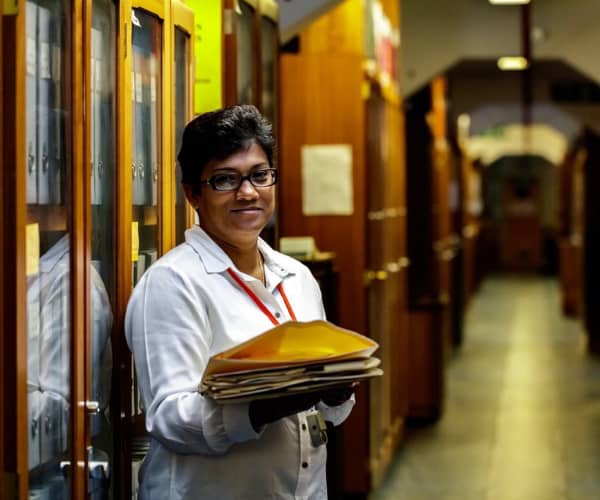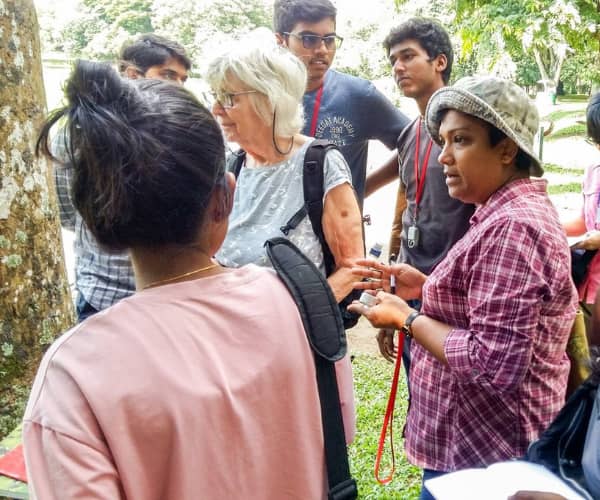
Mar 01 2022.
views 555Lichens are described as a complex life form that is a symbiotic partnership between a fungus and an alga. Although they are miniature in appearance, lichens provide a means to convert carbon dioxide in the atmosphere to oxygen through photosynthesis, which we all need to survive. Apart from that researchers are now utilizing lichens as bio-indicators to determine the nitrogen footprint, which is considered to be far more dangerous than the carbon footprint. Studying Lichenology has become a passion for Dr. Gothamie Weerakoon, Senior Curator of Lichens and Slime Moulds at the Natural History Museum, London. While managing one of the largest collections of lichens in the world, Dr. Weerakoon continues to hunt and gather lichens in order to study anthropogenic disturbances and impacts on mankind in years to come.
Speaking to Women at Work, Dr. Weerakoon explained why lichens are a unique species, their contribution to nature, her research findings, and why the youth should explore and connect with nature.

q What inspired you to study the environment?
I was always an outdoor child. Whenever I was with my cousin, I used to follow him around. My father is from Kandy and we had to transfer to several places during my childhood. We spent a lot of time in Diyatalawa because he was a military officer. During school vacations, I would be out playing with my cousin and boys in the village and therefore I was more close to plants and animals. In school, we had a subject called environment from Grade one to five. When the teacher asked us to give a list of flowering plants and seasons I already knew them. I was quite tomboyish at the time and the teachers and Principal in school would often say that.
q Why did you choose to study lichens?
After I completed A/Ls at Devi Balika Vidyalaya I entered the Open University and I did a project on forest types in Horton Plains and the Knuckles Mountain Range for my Bachelor’s. This gave me a whole lot of energy and it was the base for everything. I was able to utilize this knowledge to understand the structure and components of a forest and with this knowledge, I studied the Walauwewatta Wathurana swamp forest when I did my Master’s in Environmental Science at the University of Colombo. Likewise, I was able to join one degree with another and developed a bridge between them. Therefore I was able to learn about unique forest habitats and their locations in Sri Lanka. I gathered a lot of experience on forests and when I got selected for my Ph.D. at the Sri Jayawardenapura University my supervisors were keen that I study Lichenology. But they didn’t have to teach me about forests or the background to the subject because I already had the knowledge and experience. Therefore I only had to study lichens.
q What makes lichens a unique component of the environment?
Lichens are known as symbiotic organisms. Apart from their scientific value, they live together with other animals and plants in a friendly manner. Symbiosis means both organisms benefit from one another. One of the best examples of lichens from a scientific point of view is that they are now used as an indicator species of the world. Through an application, we use lichens to study changing environmental patterns, climate change, adverse effects of pollution, and impacts on the environment due to anthropogenic activities. Lichens are now applied in day-to-day research. I study the taxonomy and lichens are used as indicators to monitor these changes and understand how life is going to be in another 50-100 years.

q Would you like to share some findings of your research work?
I started as a taxonomist and studied the ecology of lichens. The research for my Ph.D. was based at the Knuckles Mountain Range. Here I studied the activity of lichens in 16 different habitats and prepared a lichen checklist for Knuckles. Today these are used as bio-indicators. We are monitoring lichens to understand the nitrogen pollution within the Himalayan region and adverse impacts on South Asian countries over the next 200-250 years. For that, we are studying habitats in Pakistan, India, Nepal, and Bhutan. We also established the first long-term monitoring research station in Sri Lanka and this is based at the Queensberry Tea Estate. Here we monitor lichens to determine the Nitrogen footprint. Excess nitrogen is released due to the heavy use of fertilisers. There is a growing population in South Asia and there’s a need for more food but there’s a limited land area. Nitrogen in fertilisers is released into the environment and we use lichens as an indicator species to understand the long-term effects of nitrogen on people. The nitrogen footprint is much bigger and more dangerous than the Carbon footprint. Many of us don’t know what nitrogen is doing to us. We already hear of cases where farmers and families in Polonnaruwa and other paddy harvesting regions have fallen sick. Many of these effects of nitrogen are irreversible. Natural cycles have been broken. Therefore we will look at lichens to understand regional problems and see how farming and other practices could be done in a sustainable manner. There has to be knowledge and experience to sustainably use fertilisers and maintain a balance of the environment. This is the most iconic research I have done out of all research projects I have been involved so far.
q Tell us about your experience working at the Natural History Museum in London.
It is a dream job for many of us but it has certainly been one of the best experiences in my life. As the Senior Curator of lichens and lichenised fungi, I manage over 500,000 lichens. My duty is to carry out all administrative responsibilities regarding the collection and manage it. As a researcher, I refer to the collection at the museum and collaborate with other researchers from around the world. When I worked for my Ph.D. I did my experiments and taxonomic research at the Natural History Museum. From those days, I wanted adventure-based work. I wish we had more than 24 hours a day as there is so much we could do from this collection and share with the scientific world. The Natural History Museum has the largest collection of lichens in the world and I facilitate their research. All specimens have been collected from the 16th century onwards and need to be protected for the next 200-500 years. Some of them could be the last remaining specimens in the world. Many have disappeared from their natural habitats and it's important that they are being made available. One thing we are now looking at is to digitize the collection and that way people can access the collection from anywhere in the world. We can also send lichens required by other institutions and also ensure that they go back to the collection. We also share our knowledge with the community through citizen science programmes in order to make them realize the importance of protecting plants, animals, and the environment around them.
q Bio-theft has become a growing concern in terms of wildlife crimes. How do you ensure that lichens in the collection are being protected in this context?
Bio-theft is a growing problem. In tropical countries, we need to protect our genetic transparency and resources. The museum and I believe that biological wealth should be shared among everybody and in an equal manner. We always follow the Nagoya Protocol in our institution and handle everything according to these guidelines. As such we follow necessary regulations before doing any research. Even though I’m Sri Lankan and most of my research work is focused on Sri Lanka, I still have to get the necessary clearance from the Sri Lankan government. That’s the same policy that is being applied to any country. Before working with any other colleagues or institutions we sign a material transfer agreement. We don’t violate their laws or ordinances. The Natural History Museum never accepts any collections from anybody without a collection or export permit.
q What challenges have you faced as a female researcher studying lichens?
Lichenology is an outdoor subject. Therefore I spend a good amount of time in a lab or a herbarium. The majority of my work is based outdoors and I’m always out there, hunting and gathering lichens like during ancient times. Thereafter I bring them to the herbarium. One-third of my life is spent outdoors. When I was doing my Ph.D. I had to study 16 different habitats at Knuckles. Therefore we had to camp and there was no mobile reception. It was just a few of us inside a camp, we had to cook outdoors, bathe in a river and most of my colleagues and fellow scientists were male. Therefore it was challenging. On the other hand, being accepted as an ecologist is another challenge. Our society still gives an odd look when you say you’re an ecologist and I had to learn how to ignore that look. Sometimes people would ask odd questions from me. I would spend days and weeks away from home, sleeping under trees, associating with Vedda tribes in the jungles. This is the beauty of Lichenology science. However, both of my sons were very young when I was studying for my Ph.D. and in most instances, I wasn’t able to be with them. I couldn’t attend their parent-teacher meetings, sports meets and in fact, I had to sacrifice a lot to be who I am today. It has been a tough journey and still, it is tough. Most of the time I travel and I work in field stations for a greater part of the year. However, I have no regrets.
q What is the most satisfying part of your career?
I thoroughly enjoy what I’m doing. I have 1000% job satisfaction compared to other professions. I work for the adventure, whether it is deep inside the Himalayas or uninhabited patches of land, climbing tall trees and collecting canopy lichens. I have been on hunting-gathering missions to rural locations and have studied lichens from the Arctic to the Antarctic regions and I continue to explore more in different regions around the world. It’s truly fascinating.

q Today’s younger generation has distanced themselves from nature. What is your message to them?
The younger generation should realise the importance of nature and its contribution to mankind. Today, children and youth are addicted to their electronic devices and their screen time is unlimited. Digital screen time has impacted all of us. Unless we change our lifestyles and understand how closely these biological organisms are interacting and contributing to our day-to-day lives and we bring about a change in attitudes and counter these anthropogenic disturbances to bring about a balance of the environment, our lives will not sustain us for long. We need to educate school children, youth, young adults, and adults through various science programmes. Three decades ago, a child would be able to name five flowering plants or fruit plants in their home garden. But if you ask the same question today, they will answer after referring to a textbook. Send children outdoors and allow them to explore nature. We are so addicted to digital platforms, in the future, children will not socialize and parents themselves will witness these issues.
0 Comments